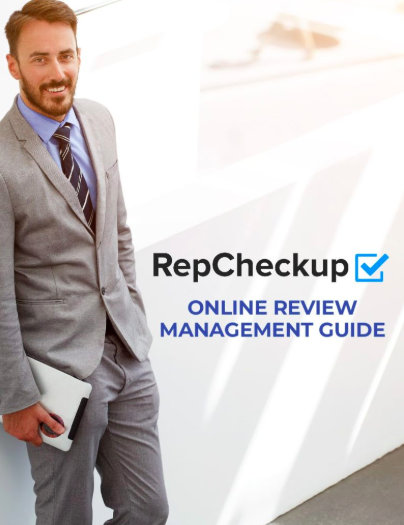How to Build an Online Reputation Management Strategy

Successfully managing your business’s online reputation requires strategic vision. Without a strategic approach, you and your team will be in a constant state of reactive fire-fighting. The result is that your reputation management efforts become focused on the negative. You miss the opportunities to build a comprehensively strong reputation that can withstand any slings and arrows with less fire-fighting on your part.
Online reputation management is a high value activity with a direct impact on your marketing, your customer service and your revenue. Treat it as such. Take the time to develop and reputation management strategy that can help you achieve clear business goals and maximize the value of your reputation.
When you define online reputation management goals and tasks within the framework of a clear strategy, your efforts and resources get deployed effectively. Reactive online reputation management wastes your resources for very little return. To develop an online reputation management strategy that will help you achieve defined goals, you must ask:
- Who in the business owns online reputation management?
- What’s your current reputation baseline?
- What are your online reputation management goals?
- Where should you be; where should you be active?
- What tasks should you be doing?
- What’s your monitoring strategy?
- What’s your response strategy?
Below we’ve provided a strategic planning roadmap around these questions you and your team can use to build the right reputation management strategy for your business.
Who owns online reputation management?
Online reputation management can’t be left in the hands of whoever on the team enjoys social media most. We’ve talked before about how your business’s reputation is one of its most valuable assets. Managing it requires and deserves clear ownership and lines of responsibility. Without clear ownership, strategy and task execution will fall by the way side.
The owner needs to be a specific person. Allocating online reputation management to a department, like marketing or customer service, is insufficient. Even though many tasks will be performed by multiple people, one person needs to have incontrovertible accountability for the performance of your reputation.
Deciding who should own online reputation management at your business depends on the size of your operation. A small shop without multiple departments may give this responsibility to the business owner or manager. Depending on the type of business, the “manager” in question could be practice manager, or floor or back-office manager. Larger businesses with more well-defined departments may give reputation management to the director of marketing, sales or customer service.
The fact that reputation sits easily in some many functions testifies to how critical it is to overall well-being and growth of your business.
What’s your online reputation baseline?
Setting goals and defining success metrics is critical to executing any sort of strategy, as opposed to simply executing workflows. Before any of that can happen, you need to create a baseline of where you are now to identify gaps, opportunities and priorities.
Start by doing an online review site audit. Put together an excel sheet where you can list all the review sites relevant to your industry. For each site, mark down:
- Does your business have a profile there?
- If yes, did you create the profile or is it a default profile?
- What’s your rating? Based on how many ratings provided?
- How many reviews are posted?
- What’s the date of the most recent review posted?
- How detailed are the reviews?
Next, conduct a social media audit, listing all the most relevant social media platforms for your market.
- Does your business have a profile there?
- What’s the size of your community, as defined by that platform?
- How often is your business posting?
- When was your business’s last post?
- What types of content do you post (e.g. announcements of discounts/sales; holiday notes, ads, etc)
- How often are people engaging with your posts or profiles?
- When was their most recent engagement with your business in social media?
- Which types of posts get the most engagement?
- What type of engagement are you getting from your community (e.g. customer service questions, pictures/posts while at your business, etc)
For both online review sites and social media platforms, you also want to document:
- How complete are your profiles? Is the information accurate? Do you have attractive photos included?
- Are you tracking whether the site is driving new customer referrals to you? Are they included in your “How did you hear about us?” surveys?
Last, make a list of your five of your biggest competitors. Look at what sites they’re on and what they’re doing there. Do they have more traction where you are or where you’re not? How do your ratings and reviews compare?
This is the raw data you’ll use in the next steps of building your reputation management strategy. Even as you’re putting this data together, some gaps and opportunities will start to reveal themselves.
What are your online reputation management goals?
Your business can achieve multiple goals, so you need to set priorities. Your online reputation management goals will change over time. When you identify short, medium and long term goals, you’ll know what you’re working towards. You’ll feel less like you’re neglecting a valuable goal that’s not today’s priority when you’ve planned to focus on it at a later point.
The first place to start is any red flags that came up when you did your baseline research. Did you notice on any site or platform that:
- You’re getting beaten handily by one or more of your competitors?
- There’s a particularly bad or inaccurate, recent review, or a prominent owner/employee personally targeted by a review?
- You have primarily only a passive presence with no claimed profiles, or unclaimed profiles on sites where your marketing and competitors are active?
Filling in any of these gaps should be your priority. Any issue that blocks you from growing your online reputation needs to get resolved first so you’re starting with at least a neutral baseline. Once you get your business on stable ground, you can move on to the more growth-oriented business goals.
Second phase goals can include growing a presence and building a bank of positive reviews on specific sites. You’ll address how to prioritize which sites to focus on in the next section. The different goals you can set for each site are:
- Bulking up number of reviews
- Improving rating
- Improving quality of reviews with more detail and even staff mentions
- Seeing a regular stream of new reviews, e.g averaging X number of new reviews each month
From here, you can start to think about revenue-generating goals, such as how a site and the reviews there drive:
- Traffic to your website
- New customer actions, such as click-to-calls, or online scheduling or ordering
There are numerous offline and online tools that will help you track and analyze the metrics relevant to each goal, as well as help you perform the tasks needed. A bit more on tools below.
Where should your business be? Where should it be active?
These are two different questions and the answers may change over time. The wonderful, challenging fact is that the number of review sites and social media platforms is immense and only growing. There are the generalist, major players like Yelp and Google My Business. Then there’s the host of industry-specific sites, which may be more valuable to your business than the generalists, such as ZocDoc, TripAdvisor, Angie’s List and Zomato.
Your baseline research provides insight where you must be, where you might want to be, and what sites you can ignore. Formalize this insight by creating a priority list of sites you want to tackle and what each site needs. You may find you have different goals for different sites.
For example, you want to have accurate, robust profile on Google My Business since that can help your SEO ranking and will be the information people first see when they google your business by name. But if most of the new traffic and review activity is on an industry-specific site, move on quickly to build your presence on that site once you’ve set up a strong GMB profile. Our reputation management tool lets you drive reviews to the site of your choice. In this scenario, it would make more sense to use it to drive reviews to the industry-specific review site instead of GMB.
Once you have a strong star rating a bank of reviews on one site, you can shift focus to achieve the same on a new site. Research shows that the 10 most recent reviews on a site have the most impact in shaping consumer behavior and that older reviews are generally ignored. The takeaway here is that you can rotate your site focus, while making sure that the most important sites for your business reach a tipping point of holding a strong overall rating and steady stream of new reviews.
What tasks should you be doing?
You’ll have both off and online tasks. Tasks can be categorized as either maintenance, those on-going tasks you need done regardless of specific goals, and special project, which are goal-specific tasks. Monitoring identified sites for new reviews or mentions is a series of maintenance tasks. Setting up a campaign to increase your star rating on a specific site is a collection of special project tasks.
When you create a task checklist for each category, don’t assign them to specific people – yet. First, document what the task entails, what staff level is responsible for doing the task, along with the when, where and how it will get done. Once that’s done, you start assigning specific people certain tasks. Don’t forget to assign back-ups for tasks too.
In some cases, tasks may fall to groups of people. For example, a restaurant may make asking for a review from happy customers a task for all wait staff. In this case, the higher-level task may be who’s responsible for training staff in these efforts.
You also need to think about how you want to divide tasks up. You can assign certain sites to people, who are then responsible for all tasks – maintenance and special task – for that site. Or you may decide to allocate tasks by function, so certain people are responsible for listening and responding, while others are responsible for increasing review quality. Let your business’s needs, and staff size and skills guide you here.
Don’t worry. You’re not on your own. Many review sites provide off- and online marketing collateral you can use to encourage reviews to their sites. You also have access to a range of online tools that can help you maintain your profiles, see what’s being said about you, send notifications when you have a new review, and automate sending out review requests.
What’s your online review monitoring strategy?
One of the most critical maintenance tasks is monitoring what’s said about your business online. Online review monitoring tools are the most efficient way to monitor what people are saying about you. Social media and review site dashboard tools can highlight and alert you to mentions and new reviews. Other tools can monitor other areas of the internet, including blogs, new sites and social media platforms we’re you’re not, for mentions.
The key question to answer for your monitoring strategy isn’t where you want to monitor. The tools let you cast a broad net. The more important question is what do you want to monitor?
You must monitor use of your official profile name and your business are name. That’s just the start. Think about other terms worth monitoring. Does your business name have a common nickname you should monitor? Do you have any signature products, services or events that might get mentioned? Have you created a branded hashtag (or do you want to)? Are there some key employees who are active online on the business’s behalf? You might want to include their names and social media profile handles to your list of monitored terms.
Last, don’t overlook keeping an eye on your competition as well. Deciding which of them to keep tabs on is also part of setting up a monitoring strategy.
What’s your response strategy?
What’s the point of all that monitoring if you haven’t also strategized how and when to respond to what you find? Setting up a response strategy means you can respond quickly and with a consistent voice.
The first steadfast rule is that you don’t need to respond to every review or post. The second steadfast rule is that you must reply to some. This applies equally to negative and positive reviews. Having a response strategy means specifying what criteria you’ll use to determine which reviews should get a response, who responds and how they’ll respond.
For example, you might decide that an employee may respond to any positive review that mentions him or her by name, but that only certain managers can respond to negative reviews of any sort. You might also create an “immediate attention” issue list. If you’re promoting a new product or service and you get a review (of either sort) mentioning it, you may decide that this sort of review always gets a response for the duration of the promotion.
When deciding what your response-trigger criteria are, look at how you’ve responded in the past. How did those interactions go and what can you learn from them? Do have clues when someone who wrote a negative review is open to resolution or if it’s just someone being a jerk and further interaction won’t improve the situation. Like your reputation management strategy itself, the more time you invest, the more you’ll learn to refine your process and criteria.
When you identify your criteria for which reviews and comments need a response, you’ll be able to categorize them into types of reviews and comments. Based on the urgency for each type, set expected response times. A positive review may have a 24-hour response time, but a negative review has a 4-hour response window. A negative review that raises one of your identified “immediate attention” issues may require an initial response within one hour.
You should also create some response templates staff can use to quickly write a response in common situations. This lets you empower more employees to respond since they have clear guidelines on when and how they can respond.
Conclusion
With a strategy and goals identified, you can then start to design a reputation management plan. Part of that plan will include reporting and metric tracking to assess the success of the strategy to achieving its stated goals.
Yet don’t forget to take a step back and baseline your overall reputation status again to ensure that your strategy remains relevant to your current status and needs. Set a schedule for re-assessing your overall strategy so you can respond as your business goals and market landscape shift.








